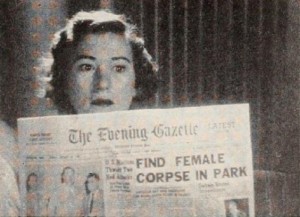
"A teen-aged girl — whose imagination has been excited by murder headlines in the local paper — and a mysterious new boarder in her mother's home are the ingredients of The Man With The Box, a superlative melodrama by James L. Watson. For here is as hair-raising a thriller as you could want to see. Mr. Watson tells his story through the interplay of image and counterimage, without benefit of dialog, and he tells it simply and well. Taut and well paced, the film should hold any audience in suspense-filled excitement from its quiet and clearly stated beginning right up to the shock of its logical and terrifying conclusion. The small cast has been cunningly chosen and wisely directed. The players, Cathy Moss as the inquisitive young girl and John Dowell as the strange boarder, give restrained yet moving performances, sustaining the film's mood admirably. The accompanying score not only complements the story line: it becomes, excitingly, an integral part of it. The Man With The Box returns to the first principles of the silent cinema with rewarding vitality." Movie Makers, Dec. 1952, 399-400.
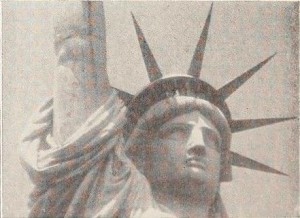
"Terry Manos is one New Yorker who has outdone himself (and all other native or visiting filmers) in recording on film the glittering surface of the world's greatest metropolis and America's premier tourist attraction. For The $24 Purchase is authoritatively stamped with the unfailing precision of the Manos technique, the perfection of his lighting and exposures, the beauty and balance of his compositions. Accompanying it is a musical score (admirably recorded) that is generally fresh and germane to the subject, a narrative that (although burdened unduly by the factual trivia of the tourist barker) is delivered with professional skill. In other words, here is a superb visual document. But a document only. For The $24 Purchase records only that surface city which the eye may see. Missing from its makeup are the searching, individual comments on that city of one human mind. Missing also — and perhaps more importantly — are the evocative emotions of one human heart, a heart reacting freely and unafraid of emotion to Manhattan's towers and tenements, to her opulent splendor and her economic ghettos. The film — tragically, if you will — has omitted any message. And, perhaps only by the margin of this omission, it has missed greatness as well." Movie Makers, Dec. 1952, 340.
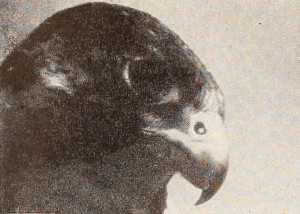
"You wouldn't think that just one movie maker could shoot all this footage (2400) on birds — no matter how interested and informed he was on the subject. And if that was the way you felt, you would be dead right. For Birds of Washington is the joint work of two men, J. Don Sutherland and Ralph E. Lawrence, who, because they customarily screen their films together, chose to submit them as one contest entry. Both, in any case, are highly competent movie makers and soundly informed students of bird life. For example, they preface briefly each new subject grouping with a pictorial survey of the type of terrain in which the birds will be found. Makes the film that much more informative. Outstanding, in our recollections, are their sequences on the American bald eagle and on an owl — whose family tree we regret we cannot recall." Movie Makers, Dec. 1952, 340.
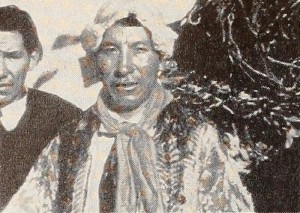
"The curious and, to many of us, unknown peoples of the Bolivian Andes are the subjects of Ciudad de la Paz (City of La Paz), an interesting and colorful film by Eduardo Douglas Di Fiore. The peasants' life, arduous and squalid amid the beauty of their mountain home, has been competently and effectively documented. Their vividly colored costumes and monochromatic, weather-beaten faces take on a new beauty through the dramatic use of an interplay between natural light and shadow, a device which is used tellingly throughout the film. There are times, however, when Mr. Di Fiore tends to belabor his point. These overlong sequences, despite the ever-present beauty and grandeur, detract on occasion from the overall quality of the picture. The music and narrative (in Spanish) complement the mood and tempo of the film effectively." Movie Makers, Dec. 1952, 340.
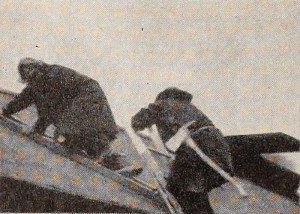
"In making Fire-Fighters Field Day, William Messner again has demonstrated his versatility with the motion picture camera. Choosing a subject which has only limited appeal, he makes it interesting nevertheless with good newsreel technique. Shooting the fire-fighting demonstration at New Haven, Connecticut, in one day's time and without advance planning, Mr. Messner captures the activities of the fire-fighters against a varied backdrop of flames, smoke, chemicals and steam. Since part of the action takes place in bright sunlight and part in shadow, the producer had to be alert in changing his diaphragm openings to insure even exposure. In view of the difficult and ever-changing light conditions, Mr. Messner deserves special commendation for the fidelity of his coverage. While the photography was outstanding, the accompanying tape track was a trifle noisy." Movie Makers, Dec. 1952, 340.
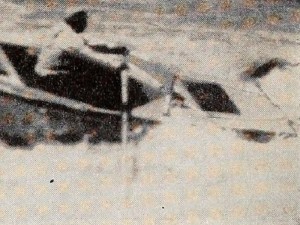
"In Grand Adventure Louise Fetzner presents a lively record of a daring run through the wild rapids of the Colorado River, as it courses the Grand Canyon from Lee's Ferry to Lake Mead. While thrilling scenes of the intrepid boats and boatmen provide the film's drama, Mrs. Fetzner has not overlooked human interest sequences on the small daily activities of these hardy adventurers. Generally good in photography and editing, the film falls off in pace somewhat in its latter portions. And perhaps the frequent inserts of a title-map of the Colorado are more hindrance than help in what is essentially an action picture." Movie Makers, Dec. 1952, 340.
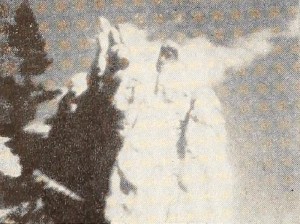
"With a thorough understanding of what constitutes human interest, L. Gordon Darby has produced in Mountain Playground an attractive record of the Banff-Jasper National Park area. Present, to be sure, are the majestic peaks, the Banff Springs Hotel with its surrounding flower gardens, Lake Louise and a picturesque river trip. But there are presented also the darting antics of a chipmunk, the dainty distrust of a cautious deer and the hungry bear within arm's reach of the camera. If camera steadiness had not been sacrificed for the ease of the hand-held camera, this attractive travelog might well have contended for higher honors." Movie Makers, Dec. 1952, 340.
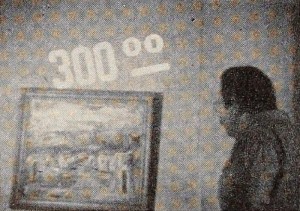
"In Paintings, George E. Canning has hung his story on a simple plot that serves to display an artist's works. A lady makes an appointment with the artist with the intent of making a purchase. The artist, beset by a pile of bills, wonders what he should charge or hope to get; and here figures expressing his thoughts are cleverly superimposed on the scenes of action. The paintings are interesting in themselves for their variety of subject matter and style (this fact rather belies the artist's penury), and the interior lighting throughout the film is excellent. The artist (John S. Arhorn) is well played by himself, the lady by Julia Canning. One could wish that the plot's denouement is not so readily anticipated." Movie Makers, Dec. 1952, 340.
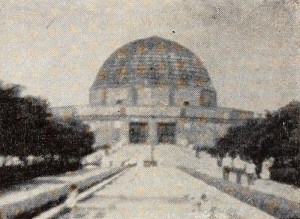
"Attempting to film a large city with its huge skyscrapers and teeming population through the lens of an 8mm. camera would seem to be an almost overwhelming task. However, boldly tackling such a gigantic project, Richard Guetl in his entry, The Big City, proves it can be done. This competent photographic work presents a good, clear coverage of Chicago, where Mr. Guetl resides. His angles are interesting and compositions pleasing. His street shots around the Loop and his camera treatment of the human derelicts on Skid Row are worthy of special commendation. While The Big City is not an epic, it is a capable, factual presentation with just enough skyscraper shots to make it authentic, enough stores and people to give it pulsating life, and enough pathos to arouse the emotion." Movie Makers, Dec. 1952, 340-341.
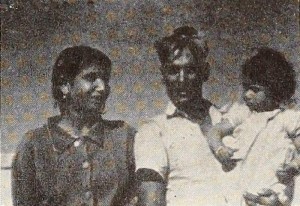
"Oscar H. Horovitz, you may recall, already has told in words (see Israel Invites, March Movie Makers) about his month-long visit of last year to this newest of the world's democracies. In The Israeli Story, with all personal references excised, he now sets forth film a record of this hard-won republic he found it. Covered, in step-by-step reporting, are its polyethnic citizens, its social, economic and educational centers, and, briefly, its hopes for the future. Supplementing this visual reportage there is a technically excellent magnetic recording on film, in which music is used sparingly and the narrative is both written and delivered with restraint. As such, The Israeli Story is a competent documentary record which should serve (and, in fact, has served) the public relations program of the new Jewish state effectively. An objective observer of the film, however, draws from it little if any of the emotional uplift which is eagerly hoped for by every sympathetic viewer." Movie Makers, Dec. 1952, 341.
Total Pages: 299